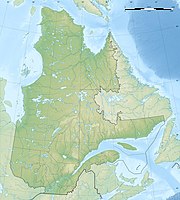Parc national d'Anticosti
|
Parc national d'Anticosti
|
||
|
The Baie de la Tour |
||
| location | Quebec , Canada | |
| surface | 571.8 km² | |
| WDPA ID | 555566992 | |
| Geographical location | 49 ° 33 ′ N , 62 ° 57 ′ W | |
|
|
||
| Setup date | 2001 | |
| administration | Parcs Québec, SEPAQ | |
The Parc national d'Anticosti is one of the currently 27 national parks in the Canadian province of Québec . There, a parc national corresponds to what corresponds to a provincial park in the other provinces . The park is operated by Sépaq ( French Société des établissements de plein air du Québec or English Society of outdoor recreation establishments of Quebec ).
The task of the 571.8 km² park on the eponymous island of Anticosti is to provide a refuge for at least 133 species of birds and 24 species of mammals. In 1985, the provincial government began to buy back the island to set up a park. This was founded in 2001.
Flora and fauna
A number of animal species have been introduced since the settlement, such as salmon , then white-tailed deer (over 100,000 live on the island today), elk (9,000 of them are allowed to be shot annually), snowshoe hares , beavers and the muskrat .
The bird population differs only slightly from the neighboring mainland, but one of the largest colonies of bald eagles in North America exists here . Reptiles and amphibians were not originally native here, but several species of frog have been introduced.
geology
Anticosti, which formed part of the seabed for twenty million years, is now covered by a layer of sediment up to 1000 m thick. During the last ice age, the island was covered by such a heavy ice mantle that it sank up to 150 meters, only to slowly reappear about ten millennia ago. Melting ice and flowing water left numerous ravines on the island.
history
Before colonization, there were seven mammal species on the island: black bear , otter , red fox , spruce marten , deer vole and two bat species from the mouse -eared species , the Little brown bat and the Northern long-eared myotis ( Myotis lucifugus and Myotis septentrionalis ).
Although Innu hunted otters on the island , and Mi'kmaq also went to the islands, the island was probably uninhabited. Occasionally French , Basque and Portuguese fishermen came along, but they largely left the hunting grounds to the Innu. Louis Joliet , privileged by the French king , had a trading post built in the north-west of the island in 1681, which his son Charles continued as Seigneur over the island, but after his death the post fell into disuse. Although Anticosti was sold to a corporate consortium, it was never used by the new British colonial rulers.
In 1872 the company known as the Forsyth Company acquired the island. Some Acadians and Newfoundlands settled at English Bay, at Lance au Cutter, and at Fox Bay. Despite several bankruptcies, the Canadian government refused to buy back Anticosti.
Henri Menier , who bought Anticosti in 1895, imported 150 doe from Virginia . Today their population is estimated at more than 150,000 animals. However, the settlement of bison and elk or red deer failed. From 1899 the government, against their opposition, relocated the settlers to Renfrew and Perth in Ontario , and even to Dauphin in Manitoba .
There were now 200 settlers in Bay-Holy-Clare, 127 in L'Anse au Cutters and 14 on the Fox River. Menier died in 1913, followed by his brother Gaston Menier as the owner of the island. He sold it in 1926 to the Anticosti Corporation , which cleared a significant part of the forest until 1929. In 1931 Anticosti went to the Consolidated Paper Corporation , which was the first to try its hand at tourism.
It was not until the beginning of the 20th century that the typical North American deforestation began. From 1908 to 1918 1.8 million m³ were felled, from 1926 to 1930 1.3 million, from 1946 to 1971 it was only 0.145 to 0.36 million per year.
In 1974 the Québec government bought the island back for $ 26,363,000 and established a sanctuary. It covered 572 km², plus two ecological reserves , namely Pointe-Heath (19 km²) and Grand-Lac-Salé (24 km²).
After the total collapse of the forest, the amount of wood has increased again since 1995 (0.1 million); in 2005 it was 0.175 million m³ increased.
literature
- The research scientifique dans les Parcs nationaux québécois. Priorités et potentiels de recherche , published by Parcs Québec and Sépaq, undated, pp. 31–35.
See also
Web links
- Parc national d'Anticosti (French)
- Anticosti Island , vd Université Laval (Eng.)


